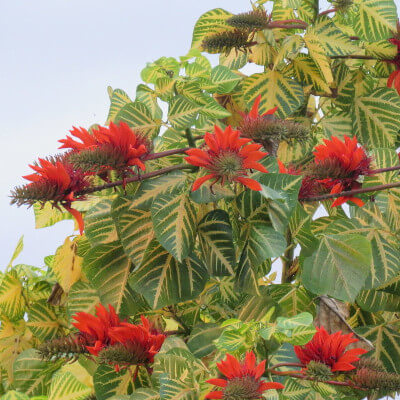
Erythrina variegata, more commonly known as Indian Coral Tree, is a striking tree highly valued in tropical botanical gardens. Native to the warm regions of Asia and the South Pacific, this deciduous tree draws attention with its vivid red flowers that bloom on bare branches. Its dramatic appearance makes it a true showpiece in botanical spaces such as the Au Bois Vert garden in Ivato, near Antananarivo.
The Erythrina variegata, or Indian Coral Tree, can grow up to 20 metres tall and is easily recognised by its thorny trunk and glossy, three-lobed leaves. During its flowering season, the tree is adorned with coral-red tubular blossoms that attract birds and pollinators alike, bringing a lively burst of colour to its surroundings. Thanks to its fast growth and resilience in tropical climates, it is frequently planted for shade or used as a windbreak in agricultural areas.
Beyond its visual appeal, this tree also plays an important ecological role. Its roots enrich the soil by fixing nitrogen, thereby boosting the fertility of the surrounding land. In a botanical garden, it helps maintain ecological balance while delighting visitors with its lush, tropical presence.
Whether you’re staying at the Au Bois Vert hotel or dining at its restaurant, a stroll through the garden will reveal the splendour of this remarkable tree. Erythrina variegata stands not only as a symbol of natural beauty, but also as a living testament to the rich tropical biodiversity preserved in places like Ivato, near Antananarivo.
Plant use
Erythrina variegata serves a variety of purposes, both practical and traditional. In many parts of Asia, this tree is primarily used to provide shade for crops such as coffee, cocoa, and tea, thanks to its dense foliage. Its ability to thrive in tropical climates and its rapid growth make it an ideal choice for farmers looking to protect their plantations. Beyond its agricultural value, the Nourouc plays a significant role in traditional medicine. The bark is used to treat a range of ailments, including inflammation, joint pain, and digestive issues. Its leaves, rich in nutrients, are sometimes fed to livestock, while the flowers and seeds offer a natural source of antioxidants. Within local communities, the lightweight wood of Erythrina variegata is often crafted into artisanal objects and dugout canoes, as it is easy to carve. The tree also holds cultural significance: in certain regions, it is planted near temples or places of worship as a symbol of protection and prosperity. For a botanical garden such as Au Bois Vert, this tree offers more than just ornamental beauty. It embodies a vital connection between ecology, culture, and agricultural tradition. As you wander through the garden paths in Ivato, near Antananarivo, you’ll encounter a tree full of character—an enduring symbol of the harmonious bond between humans and the natural world.
Key information
| Common name | Indian Coral Tree |
| Scientific name | Erythrina variegata |
| Origin | Tropical Asia and the South Pacific |
| Natural habitat | Hot and humid regions, tropical and coastal forests |
| Life cycle | Perennial, fast-growing tree |
| Flowering period | Late winter to early spring |


